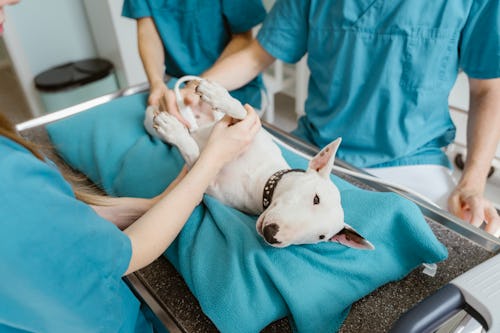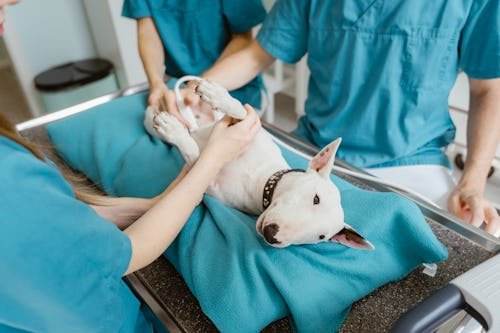
“Your dog needs surgery.” It’s the news no pet owner wants to hear, both from your heart and your wallet’s perspectives. However, serious medical procedures are something pet owners often eventually encounter, whether your cat eats something it shouldn’t or your dog develops a serious condition. It leaves pet owners asking one of the toughest questions: Just how much should, can, and will they spend on a pet emergency?
For some, it is part of a larger question of how much budget and savings they’ve allotted for pet care in general. A recent survey found that pet owners spent an average of $2085.60 on pet care in 2024. The survey also found that 55% of pet owners don’t have a specific budget for how much they’ll spend on their pets. The survey also identified that 52% of pet owners are financially prepared for unexpected pet expenses.
Christina Boniello, a dog owner from Ridgewood, N.J., estimates she spent around $10,000 per dog after both were diagnosed with different cancers a few weeks apart. “For me, there was never any question. I would do whatever I had to do to give my dogs their best chance. We got an estimate from the vet up front and paid weekly. I was willing to drain bank accounts to give them a shot,” she says. She wishes more people would realize that when they bring a pet home, emergencies are part of what they are signing up for — and saving for.
Costly Procedures
Dr. Michelle Dulake, veterinarian and co-founder and CEO of Fera Pets, says surgeries like ACL repairs, as well as chronic conditions such as kidney failure or autoimmune diseases that require hospitalization or long-term management, can be the most costly. “These can range anywhere from $3,000 to over $10,000, depending on the situation, and sometimes more if you’re dealing with specialists or intensive care. It is overwhelming and heartbreaking, especially when the decision needs to happen fast.”
She adds, “Some of the most expensive veterinary procedures often stem from emergency situations, cancer treatments, orthopedic surgeries like CCL repairs or fracture fixations, and chronic illnesses that require ongoing care. Chronic conditions such as diabetes, heart disease, or hyperthyroidism can lead to significant long-term costs.”
Buying Time
As with any medical decision, pet owners must weigh the costs against the benefits — including how much time they might (literally) be buying their pet.
Our vet was as honest and upfront as he could have been, but I wish I’d been given a better idea of a realistic estimated timeframe for each dog based on their diagnosis to make a more educated decision about what ‘tier’ of treatment was our best choice," Boniello says.
Sometimes, knowing when not to choose an expensive procedure is loving, too. "When it comes to deciding how much is ‘too much,’ I recommend balancing three key factors," Dulake says. They are:
1. Your pet’s prognosis and quality of life. Is the treatment likely to result in a meaningful recovery or comfortable management?
2. Your financial reality. It’s OK to set a limit when caring for your pet, as it shouldn’t jeopardize your family’s stability.
3. Your emotional bandwidth. Some treatments require intense time and energy — make sure the decision fits your lifestyle and capacity. These decisions are never easy, and as vets, we’re here to support you without judgment, as our goal is to help you make the best possible choice for both you and your pet.
The Decision of Pet Insurance
Some pet owners love pet insurance, while others are hesitant and opt instead to save for emergencies on their own. The North American Pet Health Insurance Association estimates that over 6 million cats and dogs are insured in the United States, up 12.7% from 2023. The average annual premium ranges from $193 for accident insurance only to almost $750 for accident and illness insurance.
"Get pet insurance while the pet is still young," encourages Dr. Hillary Wolfe, a veterinarian and veterinary advisor to Vetnique. "The longer the pet goes without a policy, the higher the chance they could develop a chronic condition. Most insurance companies won’t cover conditions the pet had prior to the policy, so it’s best to be proactive."
Dulake credits insurance for making some lifesaving procedures possible. "One case that stands out is a young golden retriever who developed a gastrointestinal obstruction after swallowing a toy. The surgery and post-operative care totaled nearly $8,000. The family chose to go ahead with treatment because they had pet insurance, which helped offset a large portion of the cost," she says.
Prevent a Problem
Though you can’t always save enough to cover a full emergency, and proactive care won’t stop every condition, there are some steps you can take to lessen the chance of being in the situation of having to choose between your pet and your financial health.
“Start a pet health savings fund (ideally before adopting a pet, but you can start this anytime!) — having some money on hand can take the stress off when unexpected bills pop up. Putting the money into a high-yield savings account is even better, since this will give you higher returns,” Wolfe says.
She adds, “Keep up with preventative care — vaccines, parasite preventions, supplements, and a very high-quality diet can go a long way towards reducing medical bills in the long run.”
Medical credit cards like Care Credit can come in handy if you are in a pinch, Wolfe adds.
Have the Tough Convos and Listen to Your Gut
Rachel Cao, an end-of-life doula in Brooklyn, N.Y., recalls getting a call from a family. They were overwhelmed at the animal hospital and said that their sweet dog, Ruby, had most likely ingested something. The veterinarian recommended either surgery or euthanasia because of the pain Ruby was in.
“My clients were in shock. They had always expected their dog to pass from the terminal diagnosis and not something like an ingested foreign object. In addition, Ruby was 16 years old and not in the best health, so the chances of a successful surgery were not very high,” she says. “They had already spent so much money over the past four years managing the symptoms of Ruby’s disease. To make the decision for surgery that would cost them thousands of dollars was a difficult one for them.”
They spent some time with the dog and dug deep to realize they had a gut feeling that she had more life left to live and “wanted to fight,” Cao says. “It was such a profound realization for them that they decided to move forward with the surgery, even though it would put them in a financially difficult situation,” she says. The surgery was a success.
Sometimes, it’s not a gut feeling but a tough conversation with your family.
“I do think it’s important to talk about both the emotional side and the financial reality, as surgeries and procedures for your pets can be insanely expensive, even with insurance. That said, I believe that loving your pet means doing everything you can with the resources you have, and sometimes just having those conversations is one of the hardest parts,” says Breanna Walther, pet parent in Palm Beach, Fla. Her second cat Olive, had only been adopted for a year and was “young and full of life” when they discovered a kidney failure.
“My husband and I had to sit down and have a really difficult conversation about how much we could realistically afford to spend, and we spoke closely with our vet to understand what her chances of survival were, what procedures were absolutely necessary, and what procedures we could hold off on for the time being. It’s not a fun or easy decision to make when you’re looking at potentially thousands — sometimes tens of thousands — of dollars to save your pet’s life, because pets are family members.”
Questions to Ask Your Veterinarian
Dulake shares the following list of questions and considerations to ask your vet if you find yourself in this situation:
- What exactly is the diagnosis or suspected problem?
- How certain are you about the diagnosis? Do we need more tests to confirm it?
- What are all the treatment options—both aggressive and conservative? What is the goal of each option (e.g., cure, management, comfort)?
- What happens if we do nothing?
- What is my pet’s current quality of life, and how might that change with or without treatment?
- What is the expected prognosis with treatment? Without it?
- Will my pet be in pain or discomfort during or after treatment?
- What are the estimated costs for each option—upfront and long-term?
- Are there financing options, payment plans, or insurance coverage to consider?
- What level of at-home care or follow-up will be required from me?
Honor Your Pet’s Life
If you decide not to move forward with a life-saving procedure, Cao says to take measures to honor the life they lived and to process your feelings.
“That is an incredibly difficult and personal decision. Find people around you who will support you and listen. And whether you have moments, days, or months left to spend with them, there are still some decisions you can make to honor their life and give them the most comfort,” she says. “If there is not much time, you can simply hold them, speak to them, and give them a peaceful space to be with you. If you have more time, create a bucket list, celebrate their life while they are still there, spoil them, and you might even want to plan for their transition day so that it is full of meaning, comfort, and peace for all involved.”
Disclaimer: This story has not been edited by us and is published as shown on Scary Mommy.


Leave a Reply